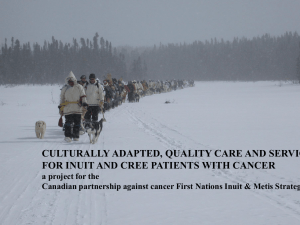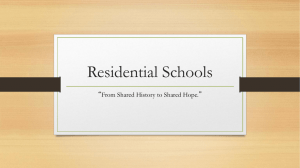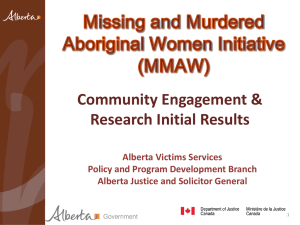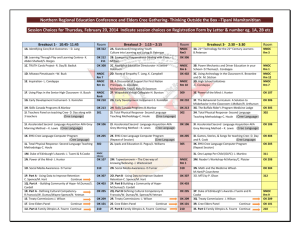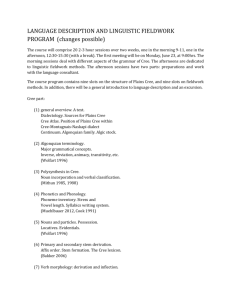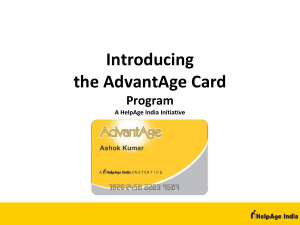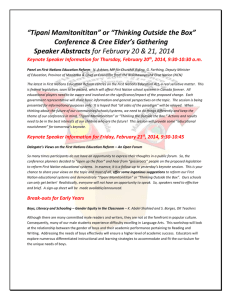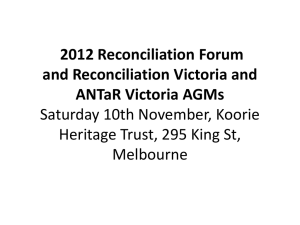Can traditional aboriginal Healers and Medicines
advertisement
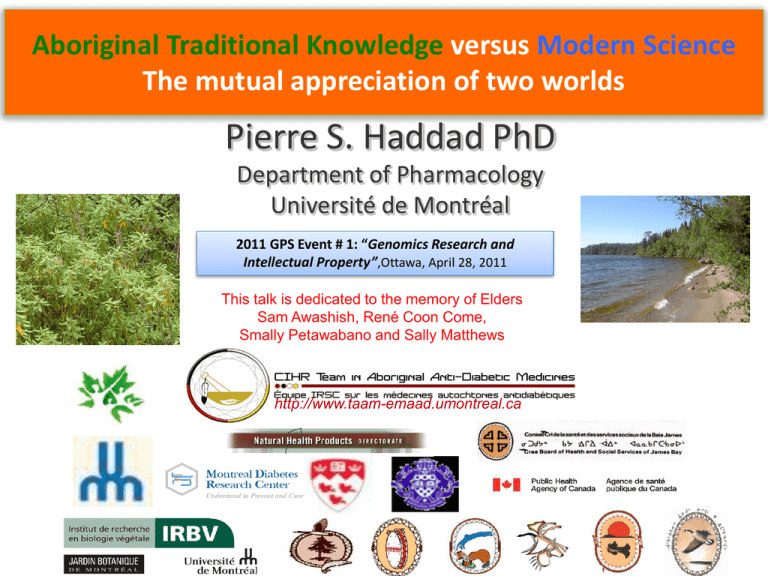
Aboriginal Traditional Knowledge versus Modern Science The mutual appreciation of two worlds Pierre S. Haddad PhD Department of Pharmacology Université de Montréal 2011 GPS Event # 1: “Genomics Research and Intellectual Property”,Ottawa, April 28, 2011 This talk is dedicated to the memory of Elders Sam Awashish, René Coon Come, Smally Petawabano and Sally Matthews http://www.taam-emaad.umontreal.ca WHY AM I HERE ?? • Bring point of view of Canadian Aboriginals (First Nations, Inuit and Métis) – Bad start : I’m NOT a Canadian Aboriginal – Origins = S. Mediterranean + N. Africa/Middle-East • Point of view of an academic doing research on Aboriginal Health 2 HOW DOES ABORIGINAL TRADITIONAL KNOWLEDGE LINK WITH GENOMICS RESEARCH?? • Hint from the Convention on Biodiversity – Access and Benefit Sharing (ABS) relating to Genetic Resources • Genetic resources in a broader sense – Includes Aboriginal Traditional Knowledge – Can be seen as an expression of human genomics (past genes, past proteins, past even behavior) • And Related IP 3 WHAT DOES INTELLECTUAL PROPERTY MEAN FOR ABORIGINALS?? CHALLENGING ISSUE • They see themselves more as custodians of Knowledge rather than actual owners • They are inspired by Natural Laws that puts their Knowledge at the service of others as opposed to personal benefit • They say that Knowledge is acquired AND gifted • They feel a responsibility to protect Traditional Knowledge 4 … AND HOW CAN THIS TRADITIONAL KNOWLEDGE BE PROTECTED?? • Case study of the Canadian Institutes of Health Research (CIHR) Team in Aboriginal Antidiabetic Medicines 5 The People & their territory: The Eeyouch (Cree) of Eeyou Istchee Population • 15,000 Eeyouch (Cree) • 9 communities • 6 communities involved in research project Legaré et al, 2004 – Project of Diabetes Surveillance amongst the Cree of Eeyou Istchee 6 Two problems addressed by the research project 1) The near abandonment of Cree healing practices and practitioners from the 1950s or so. • Nursing clinics Cree Health Board 2) The sudden rise of the diabetes ‘epidemic’ from the 1990s. 7 Problem 2: Diabetes in northern Quebec Cree community Age-adjusted prevalence of T2D in 2009 29%!!! 2009 Prevalance (%) Prevalance (%) Crude prevalence of T2D in adults > 20 in Eeyou Istchee area 25.5% 21.6% Years 17.7% Modified from Cree Board of Health and Social Services of James Bay - CBHSSJB (2005) 7.0% 8.1% 7.6% Kuzmina E, Lejeune P, Dannenbaum D, Torrie J. 2010. CREE Diabetes Information System CDIS): 2009 Annual Update. C hisasibi, Québec: Cree Board of Health and Social Services of James Bay CIHR-TAAM RESEARCH PROJECT • Explore Boreal forest plants traditionally used by the Cree to target symptoms related to diabetes • Goal: identify anti-diabetic plants which can be used by the community to help treat diabetes • How? - Collaborative Multidisciplinary Approach • • • • • • • Cree Traditional Knowledge Ethnobotany Phytochemistry Pharmacology Toxicology Clinical sciences Health systems and policy Specific concerns of Elders, communities, Grand Council of the Cree and Cree Board of Health concerning this project • Safety issues in using traditional medicines for diabetes care • Unsupervised use of medicines by others (health concern) • Question of partnership between Elders and Researchers • Use of Eeyou knowledge without consent • Ownership of intellectual property 10 Weak legal protection of Aboriginal Traditional Knowledge in Canada • • • • • Ratified Convention on Biodiversity in 1992 However, no legislation to protect Aboriginal TK Intellectual property laws not well adapted Funding agencies’ policies exist since 2008 Thus, Best Approach = – Agreements to govern transfer and use of Aboriginal TK 11 Eeyou anti-diabetic plants Research Agreement Parties: • • • • 6 Cree (Eeyou) communities Cree Board of Health & Social Services of James Bay 3 Universities (Montréal, McGill, Ottawa) 1 university hospital (CHUM) 12 Key principles of agreement 1. 2. 3. 4. 5. Confidentiality and Eeyou control over TK Review of publications Collaborative research Joint ownership of intellectual property Benefit-sharing 13 1. Confidentiality of TK and Eeyou control over use • Eeyou medicinal knowledge is confidential • Prior informed consent must be obtained from Band and Elders Councils and individual participants • Consent of Elders and communities is necessary to publish or transfer knowledge • Can only be used for specific research; consent necessary to change/expand project 14 2. Review of publications • Very important part of scientific research • Risk that TK is disclosed inappropriately • Solution = Formal Review Process – Summary and translation into Cree – Elders and communities review publications prior to it being sent to editor – Comments and extraction of TK if necessary 15 Researcher travels to discuss results with Elders -13 -8 -2 -4 -1 0 +4 weeks Researcher provides new version Elders obtain text and hold meeting to discuss Comments Researcher provides draft & summary for • other researchers • representatives of Cree Health Bd • concerned communities Plain-language summary is prepared and translated into Cree Research Cttee (RC) and communities concerned integrate Elders’ comments, tell researcher: • if any parts should be kept confidential Other researchers, RC, or communities determine if CI has been withdrawn; if not, cannot be published. If RC and/or communities disagree with interpretation, article can be published, but RC and comm can include statement. Researcher provides all parties with final version as it will appear in print. Publication deadline As early as possible Working Procedure for Review of Publications and Similar Documents RC and comms provide statement re level of support • what changes they recommend Researcher extracts confidential information (CI) and makes efforts to integrate comments. No comments RC and communities indicate which type of statement, if any, they want integrated. Submission for publication may proceed. 16 3. Collaborative community-based participatory research • Respect for Cree culture and knowledge • Transparency – Regular meetings – Reports to communities – Review of publications • Acknowledgement of Elders in publications • Communities involved in all stages – Sharing ideas and knowledge – Interpretation of results 17 4. Joint ownership of intellectual property • Results and IP are jointly owned • Elders/community members considered as co-authors, depending on contribution • Patent is a possibility but not best suited to protect TK – Danger of commodification of Aboriginal TK – Yet, minds are open (Communities and Elders have provided consent concerning initial steps for one invention) • Patenting: needs consent of Researchers and Universities as well as communities (with consultation of Elders) • 50% +1 ownership for the Cree entities; the rest for Universities 18 5. Benefit sharing • • • • • Sharing of scientific knowledge Jobs (1 full-time and occasional) Herbaria, other materials Training, apprenticeship (in progress) If commercialisation, non-profit corporation created (50% +1 Cree ownership) • Revenues to be used for – The preservation (passing on) of YK – The inclusion of TM into health care – The continued collaborative research with academic scientists 19 1) Respect = Treat Canadian Aboriginals as peers Canadian Aboriginal TK as valuable as that of any other Canadian Elders = Aboriginal Intellegentia ; Knowledge holders/keepers/transmitters ; Experts in many fields (health, forest resource management, climatic change, etc) 2) Respect = Truly Mutual ?? Involve Canadian Aboriginals from the onset of discussion (not as an afterthought) 3) Respect = Take action Let Aboriginal knowledge/wisdom permeate POLICY MEGWETCH!! Thank you!! Haddad lab CIHR-TAAM Annual retreat at Mistissini (2010)
